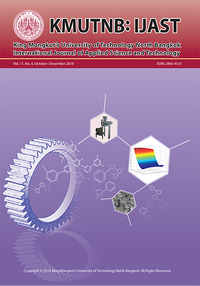Effect of Oxygen Concentration on Distributed Flame Regime
Main Article Content
Abstract
This work investigated the effect of oxygen concentrations in the reactor on the partial oxidation of JP8 under the distributed reaction condition. Reforming efficiency as high as 74% was achieved; syngas composition consisted of 20.7 to 22.3% hydrogen and 20.2 to 21.5% carbon monoxide. Reformate product distribution and quality was found to depend on the reactor oxygen concentrations and to a lesser extent on flame regime. Addition of oxygen enhanced the extent of reforming reactions, to promote increased conversion and reforming efficiency.
Article Details
How to Cite
Scenna, R., & Gupta, A. K. (2018). Effect of Oxygen Concentration on Distributed Flame Regime. Applied Science and Engineering Progress, 11(4), 235–238. https://doi.org/10.14416/j.ijast.2018.10.004
Issue
Section
Review Articles
References
[1] I. C. Lee and D. Chu, “Literature review of fuel processing,” Army Research Laboratory, U. S., Rep. ARL-TR-2946, Mar. 2003.
[2] R. Scenna and A. K. Gupta, “Dry and wet partial oxidation in a distributed reactor,” International Journal of Hydrogen Energy, vol. 42, no. 7, pp. 4102–4110, 2017.
[3] R. Scenna and A. K. Gupta, “Partial oxidation of jp8 in a distributed reactor,” Fuel Processing Technology, vol. 134, pp. 205–213, 2015.
[4] L. Hartmann, K. Lucka, and H. Köhne, “Mixture preparation by cool flames for diesel-reforming technologies,” Journal of Power Sources, vol. 118, no. 1–2, pp. 286–297, 2003.
[5] S. A. Zhdanok and P. Brovki, “Porous media combustion based hydrogen production,” in Proceedings European Combustion Meeting 2003, 2003, pp. 1–13.
[6] R. Scenna and A. K. Gupta, “Partial oxidation of JP8 in a well-insulated distributed reactor,” Fuel Processing Technology, vol. 142, pp. 174–181, 2016.
[7] R. Scenna and A. K. Gupta, “Preheats effect on distributed reaction fuel reforming,” in Proceedings of the ASME 2015 Power and Energy, 2015, pp. 1–7.
[8] P. Rawson, “Evaluation of a jet fuel thermal stability rig,” DSTO Platforms Sciences Laboratory, Australia, Rep. DSTO-TR-1643, 2004.
[9] V. K. Arghode and A. K. Gupta, “Investigation of reverse flow distributed combustion for gas turbine application,” Applied Energy, vol. 88, no. 4, pp. 1096–1104, 2011.
[10] Reaction Design. (2015). Chemkin. Reaction Design. San Diego, CA [Online]. Available: http://www.reactiondesign.com
[11] E. Ranzi, A. Frassoldati, R. Grana, A. Cuoci, T. Faravelli, A. P. Kelley, and C. K. Law, “Hierarchical and comparative kinetic modeling of laminar flame speeds of hydrocarbon and oxygenated fuels,” Progress in Energy and Combustion Science, vol. 38, no. 4, pp. 468–501, 2012.
[12] A. Violi, S. Yan, and E. Eddings, “Experimental formulation and kinetic model for jp-8 surrogate mixtures,” Combustion Science and Technology, vol. 174, pp. 399–418, May 2002
[2] R. Scenna and A. K. Gupta, “Dry and wet partial oxidation in a distributed reactor,” International Journal of Hydrogen Energy, vol. 42, no. 7, pp. 4102–4110, 2017.
[3] R. Scenna and A. K. Gupta, “Partial oxidation of jp8 in a distributed reactor,” Fuel Processing Technology, vol. 134, pp. 205–213, 2015.
[4] L. Hartmann, K. Lucka, and H. Köhne, “Mixture preparation by cool flames for diesel-reforming technologies,” Journal of Power Sources, vol. 118, no. 1–2, pp. 286–297, 2003.
[5] S. A. Zhdanok and P. Brovki, “Porous media combustion based hydrogen production,” in Proceedings European Combustion Meeting 2003, 2003, pp. 1–13.
[6] R. Scenna and A. K. Gupta, “Partial oxidation of JP8 in a well-insulated distributed reactor,” Fuel Processing Technology, vol. 142, pp. 174–181, 2016.
[7] R. Scenna and A. K. Gupta, “Preheats effect on distributed reaction fuel reforming,” in Proceedings of the ASME 2015 Power and Energy, 2015, pp. 1–7.
[8] P. Rawson, “Evaluation of a jet fuel thermal stability rig,” DSTO Platforms Sciences Laboratory, Australia, Rep. DSTO-TR-1643, 2004.
[9] V. K. Arghode and A. K. Gupta, “Investigation of reverse flow distributed combustion for gas turbine application,” Applied Energy, vol. 88, no. 4, pp. 1096–1104, 2011.
[10] Reaction Design. (2015). Chemkin. Reaction Design. San Diego, CA [Online]. Available: http://www.reactiondesign.com
[11] E. Ranzi, A. Frassoldati, R. Grana, A. Cuoci, T. Faravelli, A. P. Kelley, and C. K. Law, “Hierarchical and comparative kinetic modeling of laminar flame speeds of hydrocarbon and oxygenated fuels,” Progress in Energy and Combustion Science, vol. 38, no. 4, pp. 468–501, 2012.
[12] A. Violi, S. Yan, and E. Eddings, “Experimental formulation and kinetic model for jp-8 surrogate mixtures,” Combustion Science and Technology, vol. 174, pp. 399–418, May 2002


